Urban Land-Use Type Influences Summertime Water Quality in Small- and Medium-Sized Urban Rivers: A Case Study in Shanghai, China
Abstract
:1. Introduction
2. Materials and Methods
2.1. Study Area
2.2. Field Investigations in Urban Rivers
2.3. Measurements of Urban Water Quality Indicators
- (i)
- Physical indicators. On-site properties of sampled urban rivers were measured using a Hydrolab DS5 multiparameter water quality probe (OTT Hydromet GmbH, Kempten, Germany) at a constant depth of 0.5 m. These directly measured parameters included the temperature (Temp; °C), turbidity (NTU; nephelometric turbidity unit), dissolved oxygen (DO; milligram per liter), Blue-green Algae (BGA; cells per liter), pH (dimensionless), and conductivity (Cond; millisecond per centimeter). We also used a Li-1500 quantum sensor (Li-COR Inc., Lincoln, NE, USA) to measure the radiation absorbency (RA; percentage) for the top 0.5 m water. The RA is estimated as the ratio of above water surface radiation at 0.1 m height to the in-water radiation at a 0.5 m depth.
- (ii)
- Chemical indicators. We conducted laboratory experiments to analyze the biochemical pollutants in the collected water samples, including the total nitrogen (TN; milligram per liter), total phosphorus (TP; milligram per liter), ammonium nitrogen (NH + 4; milligram per liter), and permanganate Index (CODMN; milligram per liter), chlorophyll a (Chla; microgram per liter), total suspended solids (TSS; milligram per liter), and five-day biological oxygen demand (BOD5; milligram per liter). Determinations of abovementioned variables followed the recommended methods of ISO 4313:1976, ISO 5815:1989, ISO 10260:1992, ISO 8467:1993, ISO 11923:1997, ISO 11732:2005, and ISO 29441:2010 (International Organization for Standardization; https://www.iso.org/, accessed on 20 November 2020). The raw data are displayed in Figure S2.
2.4. Field Investigations in Urban Rivers
2.5. Remotely Sensed Data Sources
2.6. Remotely Sensed Data Validation
2.7. Spatial and Statistical Analysis
3. Results
3.1. Demonstrations of Urban Land Use Types and Summertime Water Quality
3.2. Human Settlements Determine the Summertime Water Quality
3.3. Spatial Extent Regulating Influences of Land-Use on Summertime Water Quality
4. Discussion
4.1. Influences of Urban Land-Use on the Water Quality
4.2. Evaluations on the Spatial Extent’s Regulations on Land-Use/Water Quality Relations
4.3. Pollution Control in Urban Rivers
4.4. Implications for Small- and Medium-Sized River Managements in Megacities
5. Conclusions
Supplementary Materials
Author Contributions
Funding
Institutional Review Board Statement
Informed Consent Statement
Data Availability Statement
Acknowledgments
Conflicts of Interest
References
- Ahearn, D.S.; Sheibley, R.W.; Dahlgren, R.A.; Anderson, M.; Johnson, J.; Tate, K.W. Land Use and Land Cover Influence on Water Quality in the Last Free-Flowing River Draining the Western Sierra Nevada, California. J. Hydrol. 2005, 313, 234–247. [Google Scholar] [CrossRef]
- Dobbs, C.; Escobedo, F.J.; Clerici, N.; de la Barrera, F.; Eleuterio, A.A.; MacGregor-Fors, I.; Reyes-Paecke, S.; Vasquez, A.; Camano, J.D.Z.; Hernandez, H.J. Urban Ecosystem Services in Latin America: Mismatch between Global Concepts and Regional Realities? Urban Ecosyst. 2019, 22, 173–187. [Google Scholar] [CrossRef]
- Liu, S.; Lin, M.; Li, C. Analysis of the Effects of the River Network Structure and Urbanization on Waterlogging in High-Density Urban Areas—A Case Study of the Pudong New Area in Shanghai. Int. J. Environ. Res. Public Health 2019, 16, 3306. [Google Scholar] [CrossRef] [PubMed] [Green Version]
- Li, S.; Gu, S.; Liu, W.; Han, H.; Zhang, Q. Water Quality in Relation to Land Use and Land Cover in the Upper Han River Basin, China. Catena 2008, 75, 216–222. [Google Scholar] [CrossRef]
- Zhao, J.; Lin, L.; Yang, K.; Liu, Q.; Qian, G. Influences of Land Use on Water Quality in a Reticular River Network Area: A Case Study in Shanghai, China. Landsc. Urban Plan. 2015, 137, 20–29. [Google Scholar] [CrossRef]
- Ren, W.; Zhong, Y.; Meligrana, J.; Anderson, B.; Watt, W.E.; Chen, J.; Leung, H.-L. Urbanization, Land Use, and Water Quality in Shanghai 1947–1996. Environ. Int. 2003, 29, 649–659. [Google Scholar] [CrossRef]
- Yuan, W.; James, P. Evolution of the Shanghai City Region 1978–1998: An Analysis of Indicators. J. Environ. Manag. 2002, 64, 299–309. [Google Scholar] [CrossRef]
- Tong, S.T.Y.; Chen, W. Modeling the Relationship between Land Use and Surface Water Quality. J. Environ. Manag. 2002, 66, 377–393. [Google Scholar] [CrossRef]
- Wang, X. Integrating Water-Quality Management and Land-Use Planning in a Watershed Context. J. Environ. Manag. 2001, 61, 25–36. [Google Scholar] [CrossRef]
- Razali, A.; Ismail, S.N.S.; Awang, S.; Praveena, S.M.; Abidin, E.Z. Land Use Change in Highland Area and Its Impact on River Water Quality: A Review of Case Studies in Malaysia. Ecol. Processes 2018, 7, 19. [Google Scholar] [CrossRef] [Green Version]
- Shrestha, S.; Bhatta, B.; Shrestha, M.; Shrestha, P.K. Integrated Assessment of the Climate and Landuse Change Impact on Hydrology and Water Quality in the Songkhram River Basin, Thailand. Sci. Total Environ. 2018, 643, 1610–1622. [Google Scholar] [CrossRef] [PubMed]
- De Mello, K.; Taniwaki, R.H.; de Paula, F.R.; Valente, R.A.; Randhir, T.O.; Macedo, D.R.; Leal, C.G.; Rodrigues, C.B.; Hughes, R.M. Multiscale Land Use Impacts on Water Quality: Assessment, Planning, and Future Perspectives in Brazil. J. Environ. Manag. 2020, 270, 110879. [Google Scholar] [CrossRef]
- Zerega, A.; Simões, N.E.; Feio, M.J. How to Improve the Biological Quality of Urban Streams? Reviewing the Effect of Hydromorphological Alterations and Rehabilitation Measures on Benthic Invertebrates. Water 2021, 13, 2087. [Google Scholar] [CrossRef]
- Su, Y.; Li, W.; Liu, L.; Hu, W.; Li, J.; Sun, X.; Li, Y. Health Assessment of Small-to-Medium Sized Rivers: Comparison between Comprehensive Indicator Method and Biological Monitoring Method. Ecol. Indic. 2021, 126, 107686. [Google Scholar] [CrossRef]
- Peng, G.; Xu, P.; Zhu, B.; Bai, M.; Li, D. Microplastics in Freshwater River Sediments in Shanghai, China: A Case Study of Risk Assessment in Mega-Cities. Environ. Pollut. 2018, 234, 448–456. [Google Scholar] [CrossRef] [PubMed]
- Wu, Z.; Wang, X.; Chen, Y.; Cai, Y.; Deng, J. Assessing River Water Quality Using Water Quality Index in Lake Taihu Basin, China. Sci. Total Environ. 2018, 612, 914–922. [Google Scholar] [CrossRef]
- Chen, Y.; Guo, F.; Wang, J.; Cai, W.; Wang, C.; Wang, K. Provincial and Gridded Population Projection for China under Shared Socioeconomic Pathways from 2010 to 2100. Sci. Data 2020, 7, 83. [Google Scholar] [CrossRef] [Green Version]
- Zhang, H. The Orientation of Water Quality Variation from the Metropolis River–Huangpu River, Shanghai. Environ. Monit. Assess. 2007, 127, 429–434. [Google Scholar] [CrossRef]
- Shen, Z.; Hou, X.; Li, W.; Aini, G. Relating Landscape Characteristics to Non-Point Source Pollution in a Typical Urbanized Watershed in the Municipality of Beijing. Landsc. Urban Plan. 2014, 123, 96–107. [Google Scholar] [CrossRef]
- Wu, S.; Yin, P.; Wang, M.; Zhou, L.; Geng, R. A New Watershed Eco-Zoning Scheme for Evaluate Agricultural Nonpoint Source Pollution at National Scale. J. Clean. Prod. 2020, 273, 123033. [Google Scholar] [CrossRef]
- Yin, S.; Tian, L.; Ma, Y.; Tan, H.; Xu, L.; Sun, N.; Meng, H.; Liu, C. Sources and Sinks Evaluation of PAHs in Leaves of Cinnamomum Camphora in Megacity: From the Perspective of Land-Use Types. J. Clean. Prod. 2020, 279, 123444. [Google Scholar] [CrossRef]
- Sutadian, A.D.; Muttil, N.; Yilmaz, A.G.; Perera, B.J.C. Development of River Water Quality Indices—A Review. Environ. Monit. Assess. 2015, 188, 58. [Google Scholar] [CrossRef] [PubMed] [Green Version]
- Gradilla-Hernández, M.S.; de Anda, J.; Garcia-Gonzalez, A.; Montes, C.Y.; Barrios-Piña, H.; Ruiz-Palomino, P.; Díaz-Vázquez, D. Assessment of the Water Quality of a Subtropical Lake Using the NSF-WQI and a Newly Proposed Ecosystem Specific Water Quality Index. Environ. Monit. Assess. 2020, 192, 296. [Google Scholar] [CrossRef]
- Johnson, B.A.; Iizuka, K. Integrating OpenStreetMap Crowdsourced Data and Landsat Time-Series Imagery for Rapid Land Use/Land Cover (LULC) Mapping: Case Study of the Laguna de Bay Area of the Philippines. Appl. Geogr. 2016, 67, 140–149. [Google Scholar] [CrossRef]
- Zheng, S.; Zheng, J. Assessing the Completeness and Positional Accuracy of OpenStreetMap in China. In Thematic Cartography for the Society; Springer: Berlin/Heidelberg, Germany, 2014; pp. 171–189. [Google Scholar] [CrossRef]
- Hu, T.; Yang, J.; Li, X.; Gong, P. Mapping Urban Land Use by Using Landsat Images and Open Social Data. Remote Sens. 2016, 8, 151. [Google Scholar] [CrossRef]
- Tian, L.; Ge, B.; Li, Y. Impacts of State-Led and Bottom-up Urbanization on Land Use Change in the Peri-Urban Areas of Shanghai: Planned Growth or Uncontrolled Sprawl? Cities 2017, 60, 476–486. [Google Scholar] [CrossRef]
- Turner, R.E.; Rabalais, N.N. Linking Landscape and Water Quality in the Mississippi River Basin for 200 Years. Bioscience 2003, 53, 563–572. [Google Scholar] [CrossRef]
- Zaharia, L.; Ioana-toroimac, G.; Cocoş, O.; Ghiţă, F.A.; Mailat, E. Urbanization Effects on the River Systems in the Bucharest City Region (Romania). Ecosyst. Health Sustain. 2017, 2, e01247. [Google Scholar] [CrossRef] [Green Version]
- Draus, P.; Lovall, S.; Formby, T.; Baldwin, L.; Lowe-Anderson, W. A Green Space Vision in Southeast Michigan’s Most Heavily Industrialized Area. Urban Ecosyst. 2019, 22, 91–102. [Google Scholar] [CrossRef]
- Verdú-Vázquez, A.; Fernández-Pablos, E.; Lozano-Diez, R.V.; López-Zaldívar, Ó. Green Space Networks as Natural Infrastructures in PERI-URBAN Areas. Urban Ecosyst. 2021, 24, 187–204. [Google Scholar] [CrossRef]
- Chahor, Y.; Casalí, J.; Giménez, R.; Bingner, R.L.; Campo, M.A.; Goñi, M. Evaluation of the AnnAGNPS Model for Predicting Runoff and Sediment Yield in a Small Mediterranean Agricultural Watershed in Navarre (Spain). Agric. Water Manag. 2014, 134, 24–37. [Google Scholar] [CrossRef]
- Buchanan, B.P.; Archibald, J.A.; Easton, Z.M.; Shaw, S.B.; Schneider, R.L.; Walter, M.T. A Phosphorus Index That Combines Critical Source Areas and Transport Pathways Using a Travel Time Approach. J. Hydrol. 2013, 486, 123–135. [Google Scholar] [CrossRef]
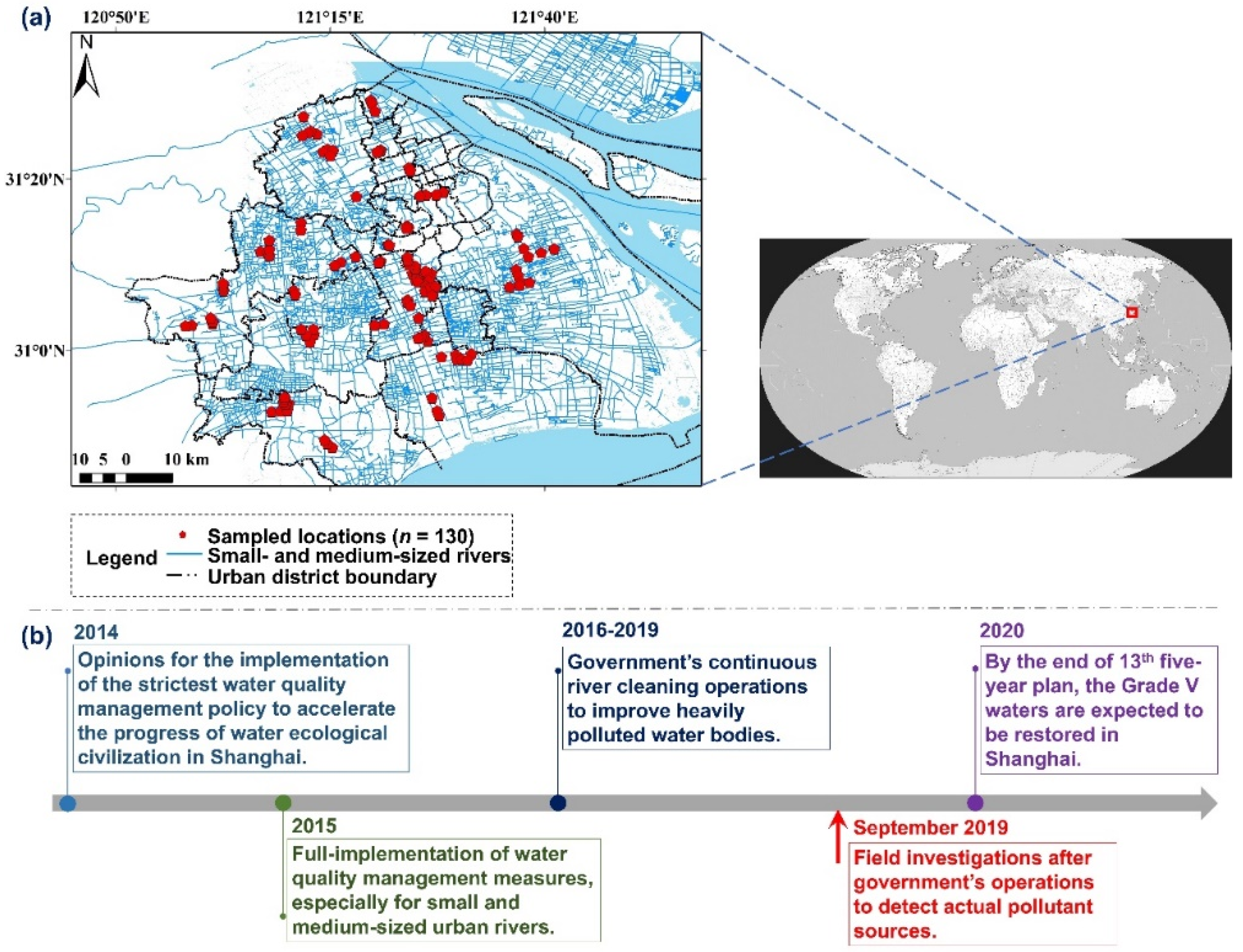
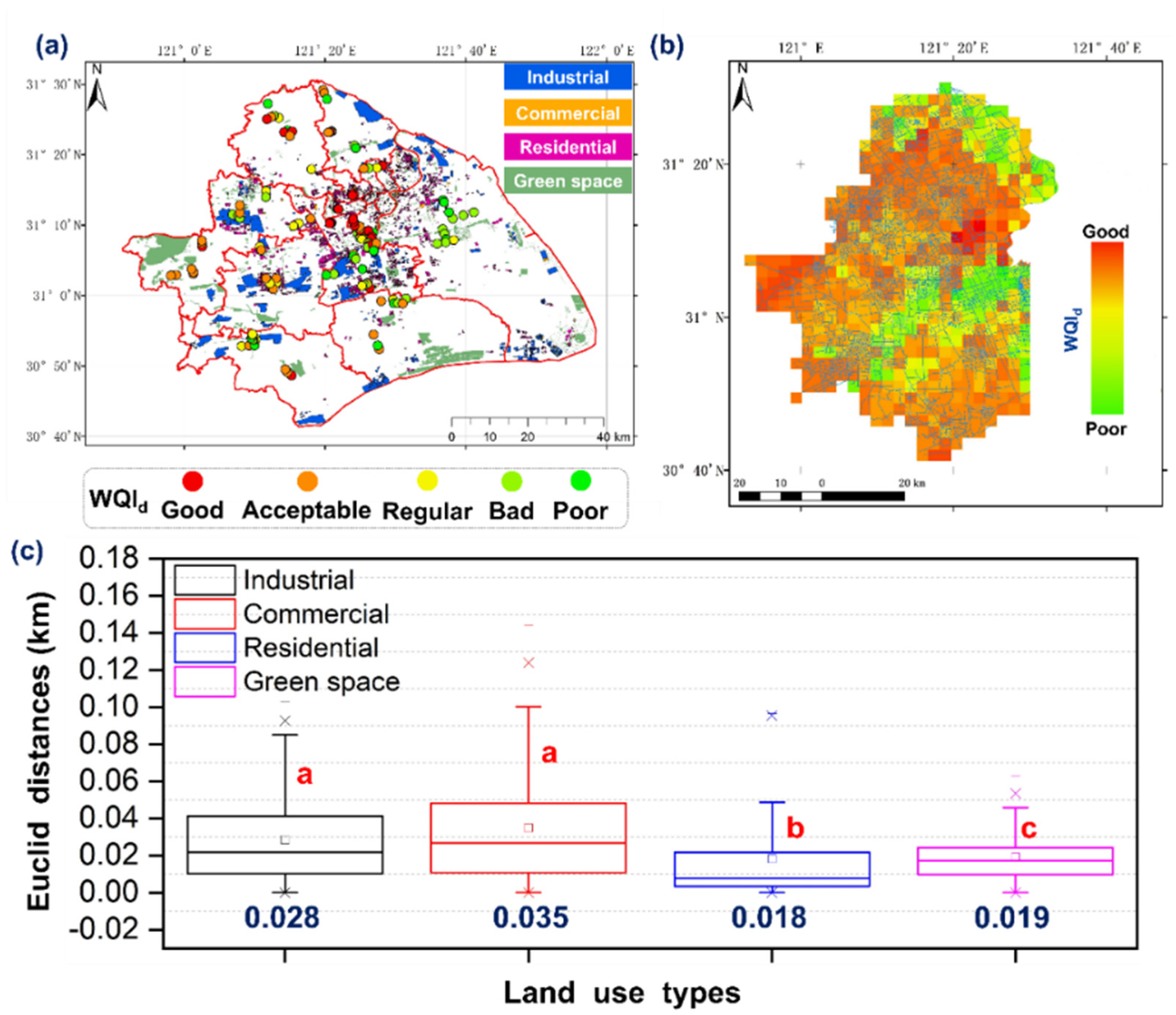
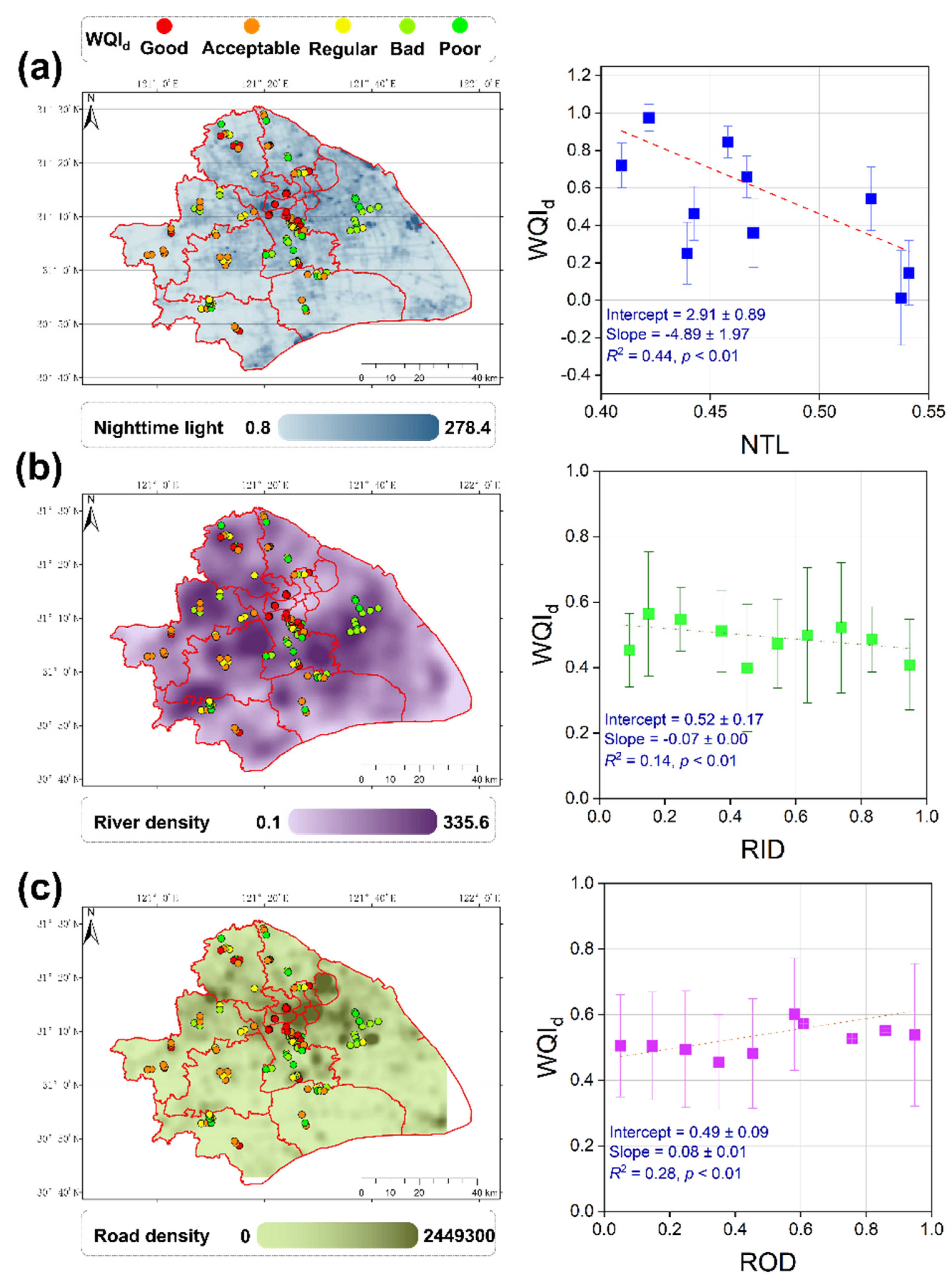

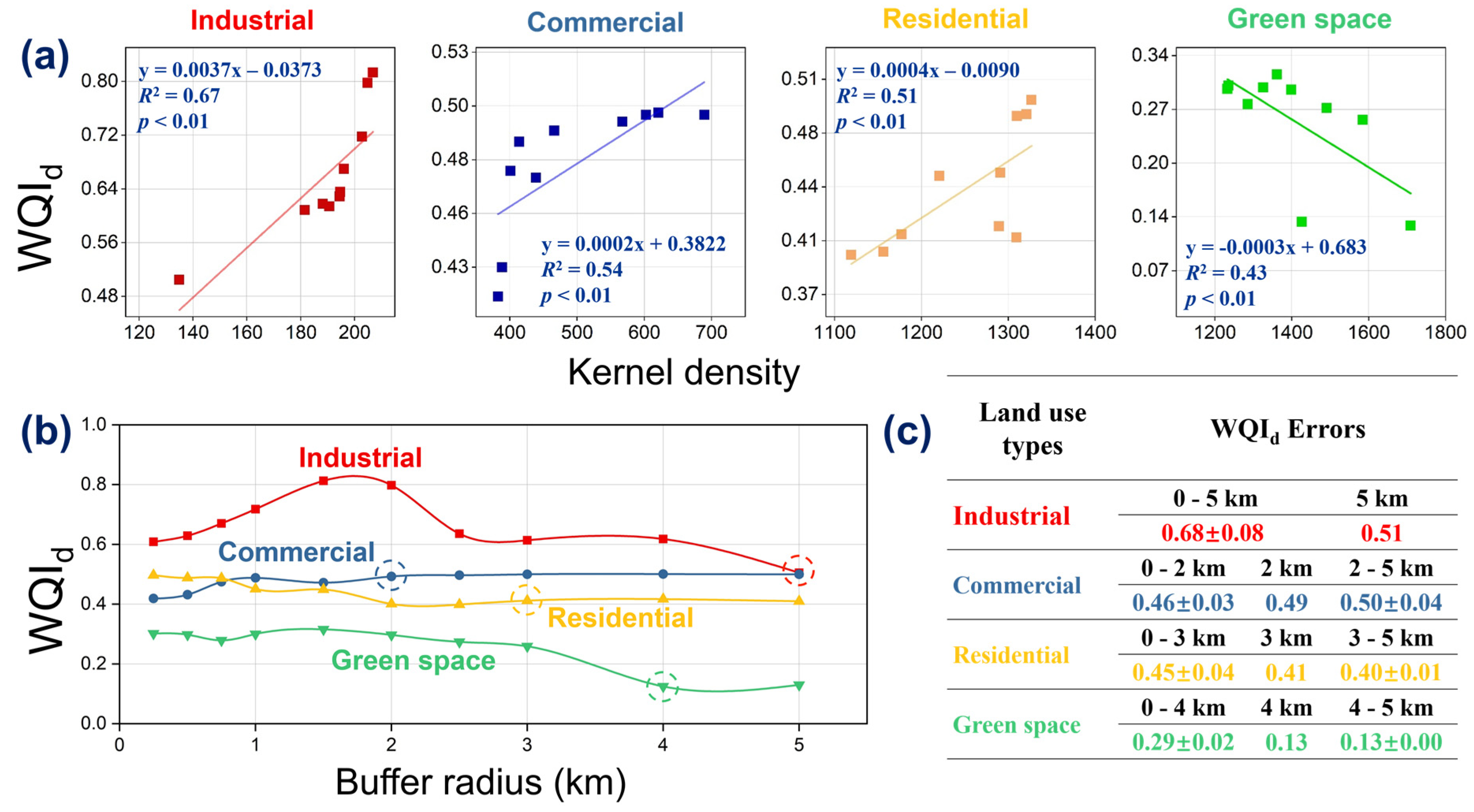
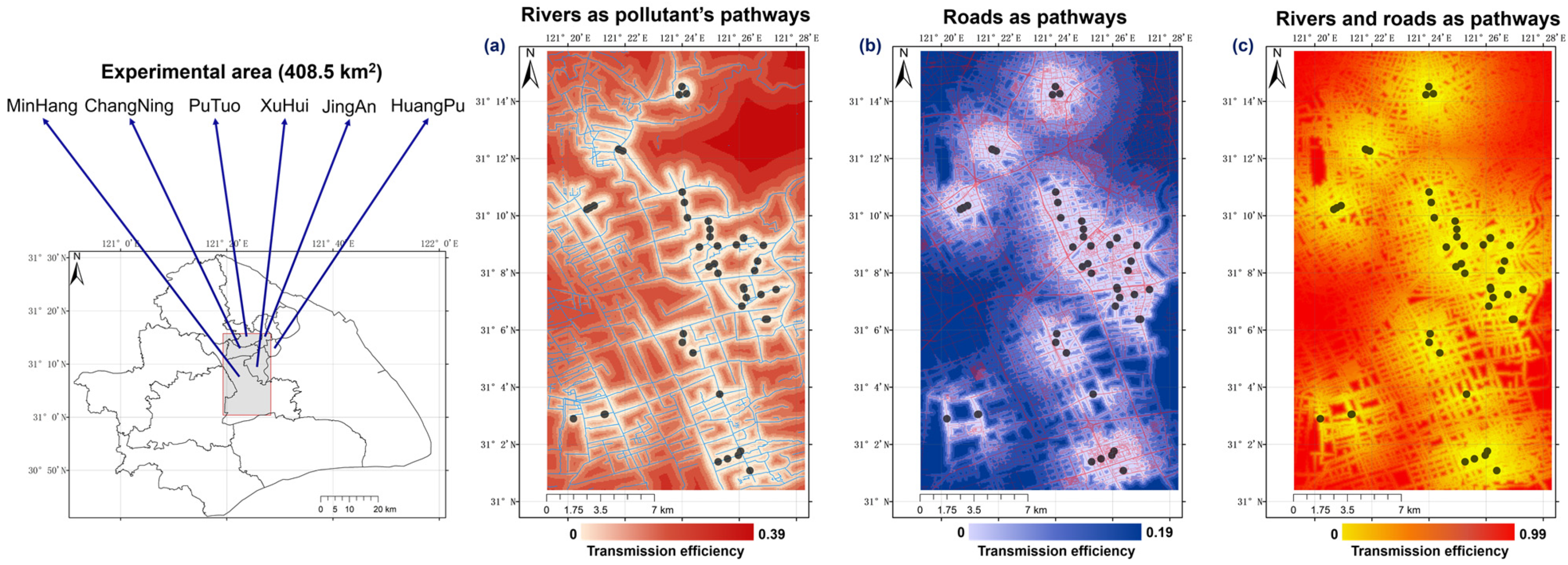
| Fixed Factors | Degree of Freedom | Sum of Squares | Mean Sum of Square | F-Value | p-Value |
|---|---|---|---|---|---|
| Land-use types | 3 | 2.38 | 1.14 | 2.37 | 0.000 |
| Nighttime light | 7 | 0.21 | 0.03 | 1.06 | 0.039 |
| River density | 3 | 0.15 | 0.05 | 1.81 | 0.050 |
| Road density | 8 | 0.16 | 0.02 | 0.69 | 0.018 |
Publisher’s Note: MDPI stays neutral with regard to jurisdictional claims in published maps and institutional affiliations. |
© 2022 by the authors. Licensee MDPI, Basel, Switzerland. This article is an open access article distributed under the terms and conditions of the Creative Commons Attribution (CC BY) license (https://creativecommons.org/licenses/by/4.0/).
Share and Cite
Liu, J.; Cheng, F.; Zhu, Y.; Zhang, Q.; Song, Q.; Cui, X. Urban Land-Use Type Influences Summertime Water Quality in Small- and Medium-Sized Urban Rivers: A Case Study in Shanghai, China. Land 2022, 11, 511. https://doi.org/10.3390/land11040511
Liu J, Cheng F, Zhu Y, Zhang Q, Song Q, Cui X. Urban Land-Use Type Influences Summertime Water Quality in Small- and Medium-Sized Urban Rivers: A Case Study in Shanghai, China. Land. 2022; 11(4):511. https://doi.org/10.3390/land11040511
Chicago/Turabian StyleLiu, Jialin, Fangyan Cheng, Yi Zhu, Qun Zhang, Qing Song, and Xinhong Cui. 2022. "Urban Land-Use Type Influences Summertime Water Quality in Small- and Medium-Sized Urban Rivers: A Case Study in Shanghai, China" Land 11, no. 4: 511. https://doi.org/10.3390/land11040511
APA StyleLiu, J., Cheng, F., Zhu, Y., Zhang, Q., Song, Q., & Cui, X. (2022). Urban Land-Use Type Influences Summertime Water Quality in Small- and Medium-Sized Urban Rivers: A Case Study in Shanghai, China. Land, 11(4), 511. https://doi.org/10.3390/land11040511






